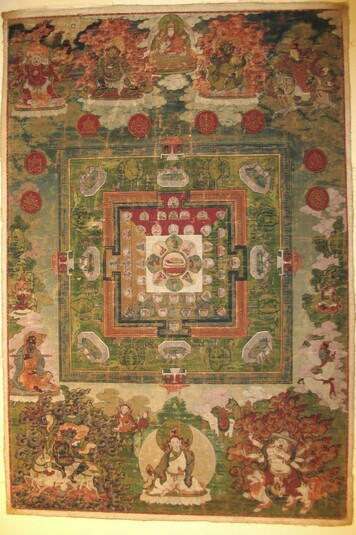
Item: Mandala of Medicine Buddha
| Origin Location | China |
|---|---|
| Date Range | 1700 - 1799 |
| Lineages | Gelug and Buddhist |
| Material | Ground Mineral Pigment on Cotton |
| Collection | Rubin Museum of Art |
Classification: Deity
Medicine Buddha Mandala. It is a common practice to replace the figure of Medicine Buddha at the center of the mandala and substitute either the figure of Prjanaparamita or to depict the Prajnaparamita text (see examples). (See Medicine Buddha Main Page).
Above the square mandala are eight red medallions containing the Eight Auspicious Symbols drawn in gold. The Seven Jewels of Royalty are also present with the the wishful-filling jewel at the middle left along with the general at the middle right. The minister, queen, wheel and elephant are located below the bottom of the mandala.
At the top center is a teacher wearing monastic dress and a yellow pandita hat. Slightly below to the left is Kutagara Vajrapani, wrathful in appearance, blue in colour. He holds upraised in his right hand a vajra scepter. In the left hand is a white skullcup.
To the lower right of the teacher is Shanglon Dorje Dudul, wrathful, holding a jewel in the right hand and a vase in the left. Shanglon is the special protector for the Four Medical Tantras of the Tibetan Tradition. Shanglon also has three different forms relating to Outer, Inner and Secret. The form depicted here is the Outer appearance and he is accompanied by four attendant deities: Yaksha Pancha, Jambhala, Mahakala and Vaishravana.
At the four corners of the mandala are the four attendant deities of Shanglon: upper left, Yaksha Pancha, red, with five faces, on the right, Norlha Karpo Jambhala, riding a horse, lower left side, Mahakala, maroon in colour, holding a stick, on the lower right Green Vaishravana, wearing a white garment.
At the bottom center is the female protector and wealth deity, Shri Lakshmi (Pal Lhamo). On the left side is Shri Devi Magzor Gyalmo. On the right side is Activity Pehar from the five forms of Pehar.
Jeff Watt 1-2013
Buddhist Deity: Medicine Buddha Main Page
Collection of Rubin Museum of Art: Painting Gallery 4
Painting Style: Qianlong Period Painting Style
Buddhist Deity: Medicine Buddha Pureland (Square Format)
Collection of Rubin Museum of Art: Mandala
Buddhist Deity: Medicine Buddha Mandala
Buddhist Deity: Medicine Buddha (Prajnaparamita)
Mahakala: Shanglon (minor figure)
Exhibition: The Art of Tibetan Medicine


